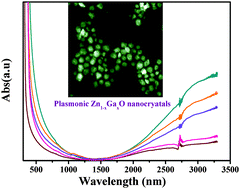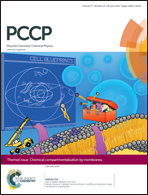Carrier concentration dependent optical and electrical properties of Ga doped ZnO hexagonal nanocrystals†
Abstract
Colloidal trivalent gallium (Ga) doped zinc oxide (ZnO) hexagonal nanocrystals have been prepared to introduce more carrier concentration into the wide band gap of ZnO. The dopant (Ga) modifies the morphology and size of ZnO nanocrystals. Low content of Ga enhances the optical band gap of ZnO due to excess carrier concentration in the conduction band of ZnO. The interaction among free carriers arising from higher concentration of Ga gives rise to narrowing of the band gap. Surface plasmon resonance absorption appears in the infrared region due to excessive carrier concentration. A broad emission band consists of blue, yellow and green colors associated with different native defects of ZnO. Intrinsic defects and extrinsic dopant Ga control the defect related emission spectrum in the visible region. Replacement of Zn by Ga induces a room temperature metallic state in a degenerate semiconductor. Cationic disorder leads to metal–semiconductor transition at low temperature strongly dependent on the concentration of Ga. Pure semiconducting behavior up to about 80 K is observed for the highest amount of Ga. Temperature dependent metal–semiconductor transition has been interpreted by localization of charge carriers due to disorder arising from random Ga substitution.


 Please wait while we load your content...
Please wait while we load your content...